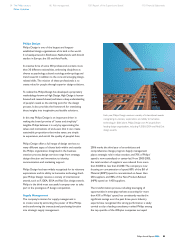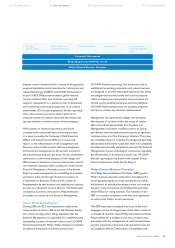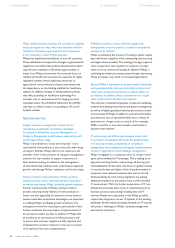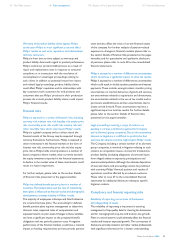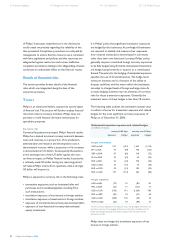Philips 2006 Annual Report Download - page 90
Download and view the complete annual report
Please find page 90 of the 2006 Philips annual report below. You can navigate through the pages in the report by either clicking on the pages listed below, or by using the keyword search tool below to find specific information within the annual report.
Philips Annual Report 200690
Philips’ global presence exposes the company to regional
and local regulatory rules, which may interfere with the
realization of business opportunities and investments
in the countries in which Philips operates.
Philips has established subsidiaries in over 60 countries.
These subsidiaries are exposed to changes in governmental
regulations and unfavorable political developments, which
may limit the realization of business opportunities or
impair local Philips investments. An increased focus on
medical and health care increases the exposure to highly
regulated markets, where obtaining clearances or
approvals for new products is of great importance, and
the dependency on the funding available for healthcare
systems. In addition, changes in reimbursement policies
may affect spending on healthcare technology. For
example, cuts in reimbursement for imaging services
mandated under the US Defi cit Reduction Act (DRA)
may have an adverse impact on spending in US out-of-
hospital markets.
Operational risks
Integral customer management is important for
maintaining a sustainable competitive advantage.
A set-back in Global Key Account Management or
Category Management could hamper expected growth
and damage Philips’ image.
Philips’ commitment to “sense and simplicity” is not
restricted to new products, it also covers the wide range
of support facilities Philips offers to its customers. An
example of this is the provision of category management
solutions for key retailers to support consumers in
their decision-making. A setback in the management
of international key retail accounts could hamper expected
growth and damage Philips’ reputation and brand image.
Failure to achieve improvements in Philips’ product
creation process and/or increased speed in innovation-
to-market may hamper Philips’ profi table growth ambitions.
Further improvements in Philips’ product creation
process, ensuring timely delivery of new products at
lower cost and upgrading of customer service levels to
create sustainable competitive advantages, are important
in realizing Philips’ profi table growth ambitions. The
emergence of new low-cost players, particularly in Asia,
further underlines the importance of improvements in
the product creation process. In addition, if Philips fails
to accelerate its innovation-to-market processes and
to ensure that end-user insights are fully captured and
translated into product creations, it may see an erosion
of its market share and competitiveness.
If Philips is unable to ensure effective supply chain
management, it may be unable to sustain its competitive
position in its markets.
Philips is continuing the process of creating a leaner supply
base with fewer suppliers, while maintaining dual sourcing
strategies where possible. This strategy strongly supports
close cooperation with suppliers to enhance, amongst
others, time to market and quality. In addition, Philips is
continuing its initiatives to reduce assets through outsourcing.
These processes may result in increased dependency.
Because Philips is dependent on its personnel for leadership
and specialized skills, the loss of its ability to attract and
retain such personnel would have an adverse affect on
its business. In addition, illness of personnel on a larger
scale, could result in business interruptions.
The retention of talented employees in sales and marketing,
research and development, fi nance and general management,
as well as of highly specialized technical personnel, is critical
to the success of Philips. In addition to personnel attraction
and retention, loss of specialized skills due to illness of
personnel on a larger scale, as a result of, for example,
SARS or bird fl u, or terrorist assaults, could result in
business interruptions.
IT outsourcing and off-shoring strategies could result
in short-term complexities. Moreover, the global increase
in IT security threats, complexities in compliance
management and complications during the implementation
of new IT applications could challenge management.
Philips is engaged in a continuous drive to create a more
open and cost-effective IT landscape. This is leading to an
approach involving further outsourcing, off-shoring and
commoditization. At the same time there is a global increase
in security threats and higher levels of professionalism in
computer crime. External requirements such as the US
Sarbanes-Oxley Act and privacy legislation are putting
additional emphasis on the need to have a well controlled
IT environment. With the further penetration of IT into
all business processes, there is also a trend towards more
business process outsourcing including data and IT
services. Finally, new acquisitions in the Philips portfolio
require the integration of new IT systems in the existing
landscape. All this makes increasing demands on IT security
and poses a challenge to Philips’ existing management
and control structures.
6 Financial highlights 8 Message from the President 14 Our leadership 20 The Philips Group





